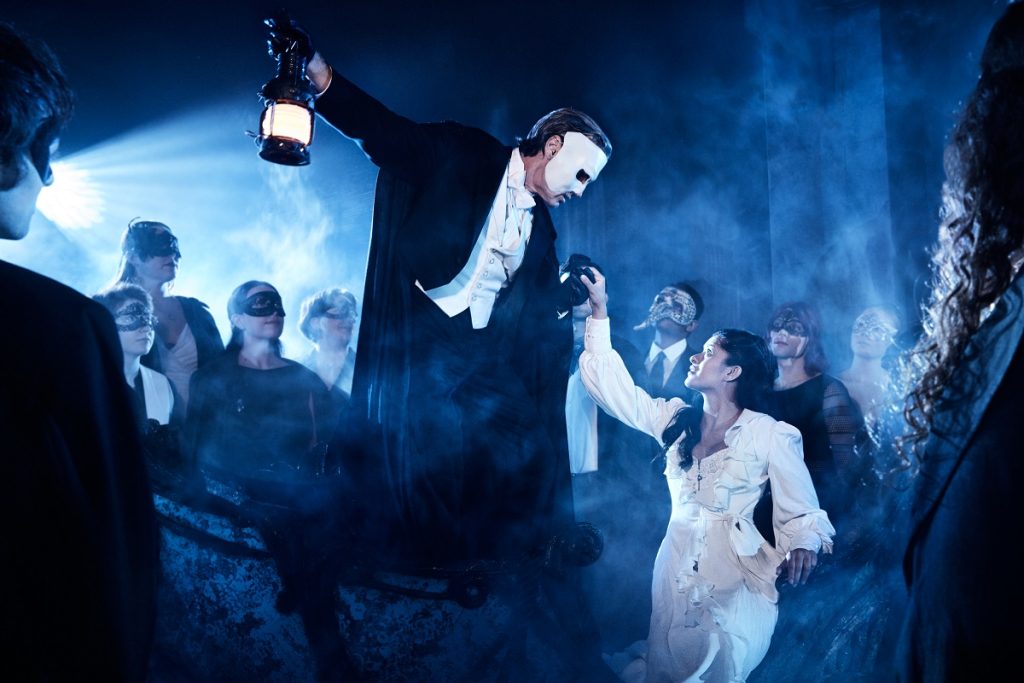Phantom, we hardly missed ye.
It’s been less than three years since Phantom of the Opera closed on Broadway after its historic 35-year run. But now it’s back. Well, not really, since Masquerade, the new immersive show “based on the original musical,” is a different breed entirely. Performed by a 28-person ensemble to groups of sixty people at a time, this reimagining delivers the highlights of the show via a series of intimate scenes, with plenty of running around in between. It also offers intriguing variations, including more of the Phantom’s backstory, a song cut from the ill-fated film version, several new scenes, and, since it runs a mere two hours sans intermission, some judicious cutting. The result sort of resembles Frankenstein’s monster, but it works exceedingly well.
There’s plenty of pomp and circumstance involved in seeing it. You’re asked to wear formal attire in black, white, or silver only. You’re required to wear a mask, and as is the case with a lawyer, if you don’t have one, one will be provided for you. And there are no physical tickets (those are so old-fashioned), with entry provided via a secret password you receive 24 hours beforehand. After all that build-up, it’s somewhat disappointing that you get a mere theatrical experience rather than an Eyes Wide Shut-style orgy.
It’s all an incredible feat of logistics, presented in a multi-level, 120-year-old midtown building that housed the venerable Lee’s Art Shop for more than six decades. Groups enter the space at 15-minute intervals, each one seeing the same show but with different casts. There are six Phantoms, six Christines, three Raouls, and two Carlottas. Among the Phantoms is a certified ringer, Hugh Panaro, who played the role more than 2,000 times on Broadway. (In what I’m sure wasn’t a coincidence, he was the Phantom at the press performance I attended.)
There’s no live music, except for the sole violinist who serenaded us with an overture from the show in an opening scene for which we’re given complimentary champagne (well, complimentary if you don’t count the ticket prices exceeding $200). There’s an interactive component, with performers recruiting you to dance with them and sometimes sitting in your lap. You’re provided with roses with which to shower Christine after she sings an aria, and artificial candles to provide atmosphere for the underground lair scene.
The physical space has been designed in spectacular fashion — not surprising, considering the show’s apparent $25 million cost — with the imaginative scenery and multitude of props thoroughly immersing you into the show’s world. Even the famous gondola ride is atmospherically recreated. And while there’s a chandelier, a very big one, it necessarily lacks the impact of the one that fell eight times a week at the Majestic. Still, it’s there.
Not everything in the adaptation created and directed by Diane Paulus, and conceived and produced by Randy Weiner, fully works. There’s a carnival scene that goes on too long, featuring a fire-eater with an incongruous Harley Quinn tattoo on his chest. And a pas de deux, performed by two robotic figures, is just silly. And although it was a fine idea to stage a climactic scene on the roof, the effect is somewhat negated by the fact that instead of looking at a Parisian skyline you’re gazing at the Nordstrom’s across the street.
But most of the evening is great fun, assuming you have the physical stamina to be constantly moving from one scene to the next, sometimes climbing stairs and other times riding escalators. You’re also on your feet for much of the evening, so it makes sense that the production has banned the wearing of stiletto heels, probably not so much out of consideration for the wearers than concern that someone may get their foot stabbed in the melee.
(On a personal note, my guest for the show is temporarily walking with the use of a cane. Not only was a wheelchair provided for her, a staff member personally escorted her for the duration of the show. By the time the evening was over, I was exhausted and my guest was fresh as a daisy. The same service is provided for any patron who needs such assistance.)
Unlike so many immersive productions, everyone sees the same show that progresses in linear fashion. Not only does it make the proceedings coherent for even those unfamiliar with the original show (hard to imagine, but they apparently exist), it spares you the anxiety generated by constantly having to choose which characters to follow. Not to mention the inevitable FOMO that results in people having to see a show multiple times to make sure they’ve caught everything.
Paulus’ staging features some truly nifty touches, such as the Phantom seeming to emerge from inside Christina’s bed to entwine her in an amorous embrace. At one point we pass through a room featuring a variety of mechanical, self-propelled devices, including a head repeatedly banging itself against a wall.
Panaro, not surprisingly, was a standout as the Phantom I saw. But there were also sterling contributions from Francesca Mehrotra’s beautifully sung Christine, Paul Adam Schaefer’s suitably dashing Raoul, and Betsy Morgan’s amusing Carlotta. You won’t necessarily see the same performers, so obviously individual mileage will vary.
Ultimately, it’s the intimacy of the environment that makes Masquerade such a special experience. You’re just a few feet away from the performers as they sing Andrew Lloyd Webber’s gorgeous score, and it’s safe to say you haven’t lived until you’ve had a performer of the caliber of Hugh Panaro singing “Music of the Night” to you directly, just inches from your face. It’s enough to make anyone a Phan.

